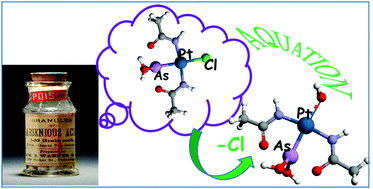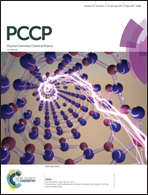The role of arsenic in the hydrolysis and DNA metalation processes in an arsenous acid–platinum(ii) anticancer complex†
Abstract
Platinum(II)-based molecules are the most commonly used anticancer drugs in the chemotherapeutic treatment of tumours but possess serious side effects and some cancer types exhibit resistance with respect to these compounds (e.g. cisplatin). For these reasons, the research of new compounds that can bypass this limitation is in continuous development. Recently, mixed Pt(II)–As(III) systems have been synthesized and tested as potential anticancer agents. The mechanism of action of these kinds of drugs is unclear. Since in other platinum(II) containing drugs, hydrolysis plays an important role in the activation of the compound before it reaches DNA, we have explored the aquation process using density functional theory (DFT), focusing our attention on the arsenoplatin complex, [Pt(μ-NHC(CH3)O)2ClAs(OH)2]. As DNA is believed to be the cellular target for Pt anticancer drugs, the metalation mechanism of DNA purine bases has been also investigated. Also for this new drug it appears that guanine is the preferred site with respect to adenine as with other platinum-containing compounds. A comparison with cisplatin is performed in order to highlight the contribution of arsenic in the anticancer activity of this new proposed anticancer agent.



 Please wait while we load your content...
Please wait while we load your content...